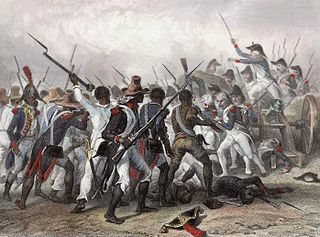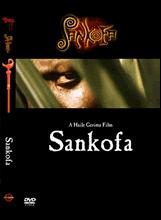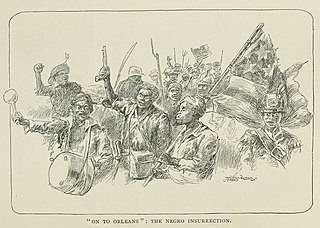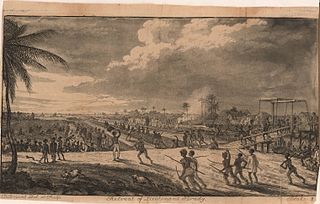Related Research Articles

Gabriel's Rebellion was a planned slave rebellion in the Richmond, Virginia, area in the summer of 1800. Information regarding the revolt, which came to be known as "Gabriel's Rebellion," was leaked before its execution, and Gabriel, an enslaved blacksmith who planned the event, and twenty-five of his followers were hanged. The site of Gabriel's execution was, for several years, believed to have been at the Shockoe Bottom African Burial Ground, historically known as the Burial Ground for Negroes. His execution was advertised as occurring at the usual place; however, in 1800, that may have been a location other than the Burial Ground for Negroes. The location of Gabriel's burial is also unknown.
Escrava Isaura is a 1976 Brazilian telenovela produced by TV Globo, originally broadcast between October 11, 1976 and February 5, 1977. Based on the 1865 novel of the same name by 19th century abolitionist writer Bernardo Guimarães, it tells the story of the struggles of Isaura, a mixed-race slave, to find happiness during the Brazilian Empire. It starred Lucélia Santos in the title role and Rubens de Falco as slave owner Leôncio Almeida, the main antagonist. It was adapted by Gilberto Braga and directed by Herval Rossano and Milton Gonçalves, running 100 episodes.

Drapetomania was a supposed mental illness that, in 1851, American physician Samuel A. Cartwright hypothesized as the cause of enslaved Africans fleeing captivity. This hypothesis centered around the belief that slavery was such an improvement upon the lives of slaves that only those suffering from some form of mental illness would wish to escape.

Barabbas is a 1961 religious epic film directed by Richard Fleischer for Dino De Laurentiis Cinematografica, expanding on the life of Barabbas, from the Christian Passion narrative in the Gospel of Mark and other gospels. It stars Anthony Quinn, Silvana Mangano, Katy Jurado, Arthur Kennedy, Harry Andrews, Ernest Borgnine, Vittorio Gassman, and Jack Palance. The screenplay is based on Nobel Prize-winner Pär Lagerkvist's 1950 novel of the same title.

Slavery in the Spanish American colonies was an economic and social institution which existed throughout the Spanish Empire including Spain itself. Indigenous peoples were enslaved and their populations decimated. Subsequently enslaved Africans were brought over. Native people were also subjected to forced conversions and conscription.

Sankofa is a 1993 Ethiopian-produced drama film directed by Haile Gerima centered on the Atlantic slave trade. The storyline features Oyafunmike Ogunlano, Kofi Ghanaba, Mutabaruka, Alexandra Duah, and Afemo Omilami. The word Sankofa derives its meaning from the Ghanaian Akan language which means to "go back, look for, and gain wisdom, power and hope," according to Dr. Anna Julia Cooper. The word Sankofa stresses the importance of one not drifting too far away from one's past in order to progress in the future. In the film, Sankofa is depicted by a bird and the chants and drumming of a Divine Drummer. Gerima's film showed the importance of not having people of African descent drift far away from their African roots. Gerima used the journey of the character Mona to show how the African perception of identity included recognizing one's roots and "returning to one’s source" (Gerima).

Black Snake is a 1973 American film directed by Russ Meyer and starring Anouska Hempel, David Warbeck, Percy Herbert and Thomas Baptiste. It was Meyer's return to self-financed projects, following the end of his brief deal at 20th Century Fox. Meyer's only attempt at the Blaxploitation genre, it was filmed in Panavision and was shot on location in Barbados. It was such a box office bomb that a film named Foxy starring Edy Williams, which Meyer wanted to follow this film, was not made.

Richard Robert Madden was an Irish doctor, writer, abolitionist and historian of the United Irishmen. Madden took an active role in trying to impose anti-slavery rules in Jamaica on behalf of the British government.

A slave insurrection started on Sankt Jan in the Danish West Indies on November 23, 1733, when 150 African slaves from Akwamu, in present-day Ghana, revolted against the owners and managers of the island's plantations. Led by Breffu, an enslaved woman from Ghana, and lasting several months into August 1734, the slave rebellion was one of the earliest and longest slave revolts in the Americas. The Akwamu slaves captured the fort in Coral Bay and took control of most of the island. They intended to resume crop production under their own control.

The Longest Memory is a 1994 short novel by British writer Fred D'Aguiar. It was the Guyana-born poet's first novel, The story takes place on a Virginian plantation, in the period before the American Civil War, between 1790 and 1810. The book is told through many different people and in different forms. It begins in the first person, with Whitechapel, the oldest and most respected slave on the plantation, recounting the sorrows of his life. From there on, each chapter is narrated by a different character, sometimes speaking through verse, via diary entry or in the second person. Most of the chapters are narrated by characters central to the story; however, chapter 11 is purely made up of fictitious editorials from the local newspaper known as The Virginian.

The 1811 German Coast uprising was a revolt of slaves in parts of the Territory of Orleans on January 8–10, 1811. The uprising occurred on the east bank of the Mississippi River in what is now St. John the Baptist, St. Charles and Jefferson Parishes, Louisiana. The slave insurgency was the largest in U.S. history, but the rebels killed only two White men. Confrontations with militia, combined with post-trial executions, resulted in the deaths of 95 slaves.

The Demerara rebellion of 1823 was an uprising involving between 9,000 and 12,000 enslaved people that took place in the colony of Demerara-Essequibo (Guyana). The exact number of how many took part in the uprising is a matter of debate. The rebellion, which began on 18 August 1823 and lasted for two days. Their goal was full emancipation. The uprising was triggered by a widespread but mistaken belief that Parliament had passed a law that abolished slavery and that this was being withheld by the colonial rulers. Instigated chiefly by Jack Gladstone, an enslaved man from the "Success" plantation, the rebellion also involved his father, Quamina, and other senior members of their church group. Its English pastor, John Smith, was implicated.

Plantation complexes were common on agricultural plantations in the Southern United States from the 17th into the 20th century. The complex included everything from the main residence down to the pens for livestock. Until the abolition of slavery, such plantations were generally self-sufficient settlements that relied on the forced labor of enslaved people.

Afro-Venezuelans are Venezuelans of African descent. Afro-Venezuelans are mostly descendants of enslaved Africans brought to the Western Hemisphere during the Atlantic slave trade. This term also sometimes refers to the combining of African and other cultural elements found in Venezuelan society such as the arts, traditions, music, religion, race, and language.

The treatment of slaves in the United States often included sexual abuse and rape, the denial of education, and punishments like whippings. Families were often split up by the sale of one or more members, usually never to see or hear of each other again.
Domingo del Monte was a writer, lawyer, arts patron, and literary critic, known primarily for contributing to Cuban literature and advocating for public education throughout the country.
Anselmo Suárez y Romero was a renowned Cuban writer and novelist, better known for the first novel in Spanish about slavery in the Americas: Francisco, based largely on "Autobiografía de un esclavo" by Juan Francisco Manzano (1835), the first autobiography written in Spanish by a slave.
Juan Francisco Manzano (1797–1853) was born a house slave in the province of Matanzas, Cuba during the colonial period. Manzano's father died before he was fifteen and his only remaining family was his mother, sister, and two brothers. Manzano worked as a page throughout his life. He wrote two works of poetry and his autobiography while still enslaved. The Autobiography of a Slave is one of only two personal accounts of 19th-century Cuban slavery, the only existing narrative accounts of slavery in Spanish America. The other is by Esteban Mesa Montejo. Irish abolitionist Richard Robert Madden published his English translation of the autobiography under the title Life of the Negro Poet in his 1840 book Poems by a slave in the island of Cuba. A second part to Manzano's autobiography was lost. He obtained his freedom in 1836 and later wrote a book of poems and a play, Zafira. In 1844, Manzano was falsely accused of being involved in the conspiracy of La Escalera. After his release from prison in 1845 he did not publish again and died in 1853.

Slavery in Cuba was a portion of the larger Atlantic Slave Trade that primarily supported Spanish plantation owners engaged in the sugarcane trade. It was practised on the island of Cuba from the 16th century until it was abolished by Spanish royal decree on October 7, 1886.

Carlota Lucumí, also known as La Negra Carlota was an African-born enslaved Cuban woman of Yoruba origin. Carlota, alongside fellow enslaved Lucumí Ferminia, was known as one of the leaders of the slave rebellion at the Triunvirato plantation in Matanzas, Cuba during the Year of the Lash in 1843–1844. Together with Ferminia Lucumí, Carlota led the slave uprising of the sugar mill "Triunvirato" in the province of Matanzas, Cuba on November 5, 1843. Her memory has also been utilized throughout history by the Cuban government in connection to 20th century political goals, most notably Operation Carlota, or Cuba's intervention in Angola in 1975. Little is actually known about the life of Carlota due to the difficulty and availability of sources in archives. Scholars of Afro-Cuban history have grappled with the dearth of reliable sources that document slaves' lives, and the ability of written documents to accurately encompass the reality of slave life. Slave testimonies obtained under investigations after rebellions provide most of the information surrounding Carlota and her contemporaries, making it difficult to construct a complete understanding of her involvement in the 1843 slave rebellion, much less a detailed biography. She is considered significant by scholars due to her role as a woman in an otherwise male-dominated sphere of slave revolt, as well as the way her memory has been employed in the public sphere in Cuba. Carlota and the uprising at Triunvirato plantation are honored as part of the UNESCO Slave Route Project through a sculpture at the Triunvirato plantation, which has since been turned into a memorial and museum.
References
- ↑ "9th Moscow International Film Festival (1975)". MIFF. Archived from the original on 16 January 2013. Retrieved 5 January 2013.
- Kaisary, Philip. (2019). Black Agency and Aesthetic Innovation in Sergio Giral’s El otro Francisco. PALARA. 23. 22-32. 10.32855/palara.2019 https://www.researchgate.net/publication/339321069_Black_Agency_and_Aesthetic_Innovation_in_Sergio_Giral's_El_otro_Francisco